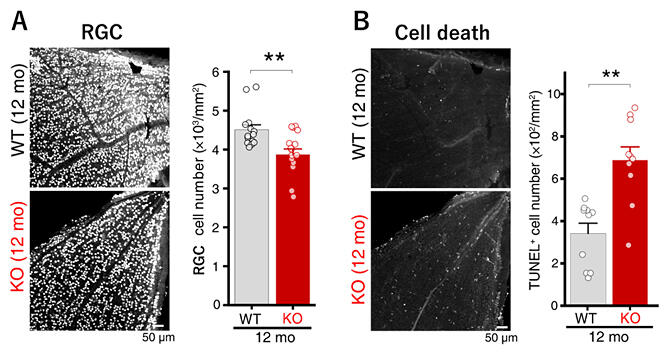The research team of Professor Schuichi Koizumi and Associate Professor Shinozaki Yohichi of the Department of Neuropharmacology, Interdisciplinary Graduate School of Medicine, University of Yamanashi, has discovered a molecule involved in the onset of normal-tension glaucoma, the cause of which was unknown until now.
Glaucoma is the leading cause of blindness in Japan. Although high pressure within the eye is the greatest risk factor, the majority of Japanese patients suffer from normal tension glaucoma, and there is an urgent need to understand the set of causes (other than the pressure within the eye). Recently, multiple genome-wide association analyses have reported that mutations in the ABCA1 gene are associated with glaucoma, but it has remained unclear why these mutations cause the disease.

B: TUNEL+ cell numbers showing cell death occurring in knock out mice.
Provided by the University of Yamanashi
The research team found abnormalities in ABCA1 in a database of genetic mutation analyses (GWAS) of glaucoma patients from around the world and proceeded to analyze them. First, they examined whether loss or gain of abnormal ABCA1 function is associated with the development of glaucoma, and then examined the effects on retinal ganglion cells (RGCs) in mice with a systemic deficiency of ABCA1. They found that the number of RGCs was significantly reduced in the retinas of the deficient mice at 12 months of age compared to normal (wild type) mice.
Next, the researchers used a variety of methods to evaluate which cells express ABCA1, and found that ABCA1 is abundantly expressed in astrocytes, a type of glial cell that is a non-neuronal cell distributed in the innermost retina and optic nerve. Therefore, they created and evaluated mice that were deficient in astrocyte expression. These deficient mice also showed a significant decrease in the number of RGCs and an increase in the number of dead cells compared to 12-month-old control mice (Ctr).
To further clarify the molecular mechanism, analysis via single-cell RNA sequencing revealed that molecules called chemokines are commonly altered in RGCs and astrocytes. Detailed analysis of RGCs revealed that certain cell populations are particularly vulnerable to injury. Additionally, the expression of Grin3a, one of the ion-channel glutamate receptor subunits (the gene encoding the glutamate receptor subtype NR3A), was greatly reduced in mice with the ABCA1 deficiency. Since NR3A inhibits glutamate-induced neuronal excitability, its decreased expression was thought to result in overexcitability and neuronal cell death due to excitotoxicity.
These research results were the product of international joint research with graduate student Alex Leung and Professor Shin-chi Ohnuma from the Institute of Ophthalmology, University College London (UCL), and were achieved with the collaboration of Project Leader Takayuki Harada at the Tokyo Metropolitan Institute of Medical Science, Professor Nobuhiko Ohno of the Division of Ultrastructural Research, National Institute for Physiological Sciences (NIPS), and of the Division of Histology, Jichi Medical University, Professor Hirohide Takebayashi of the Division of Neurobiology and Anatomy, Graduate School of Medical and Dental Sciences, Niigata University, Professor Kenji Kashiwagi of the Department of Ophthalmology, Graduate School of Medical and Nursing Sciences, University of Yamanashi, Lecturer Takahiro Segawa of the Center for Life Science Research, University of Yamanashi, and Associate Professor Kunio Miyake of the Department of Health Sciences, Division of Medicine, Graduate School Department of Interdisciplinary Research, University of Yamanashi.
Koizumi said that, "Although astrocytes and glaucoma were not easily connected, we found that ABCA1 deficiency causes inflammation of retinal astrocytes and causes glaucoma-like symptoms. In the future, we would like to evaluate the optic neuroprotective effects of candidate compounds that suppress astrocyte abnormalities, and to advance the search for new drugs for normal tension glaucoma."
■ Astrocytes: A type of glial cell. Astrocytes are the largest and most numerous cell type and have long been thought to play a role in brain support and homeostasis. They have recently been shown to be actively involved in information processing in the brain. They are also present on the innermost retinal surface and around the optic nerve.
Journal Information
Publication: Science Advances
Title: Astrocytic dysfunction induced by ABCA1 deficiency causes optic neuropathy
DOI: 10.1126/sciadv.abq1081
This article has been translated by JST with permission from The Science News Ltd. (https://sci-news.co.jp/). Unauthorized reproduction of the article and photographs is prohibited.




